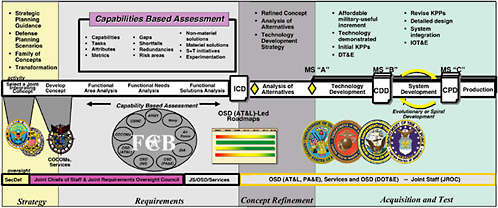4
Navy Participation in Capabilities-Based Planning Processes of the OSD and OJCS
This chapter contains a description of the status of the capabilities-based planning (CBP) processes of the Office of the Secretary of Defense (OSD) and the Office of the Joint Chiefs of Staff (OJCS). It also provides an assessment of the Navy’s participation in these CBP processes and presents recommendations for improvements in the Navy’s participation.
HIGHLIGHTS
I expect all stakeholders in the Department to participate in these efforts to address joint operational needs effectively and to improve the management of Defense Resources.
Donald Rumsfeld, Secretary of Defense Memorandum of October 31, 2003
The committee was quick to recognize that the Department of Defense’s (DOD’s) capabilities-based planning process is not yet well defined or structured for managing defense resources. Nevertheless, the Secretary of Defense is currently using it as his primary process to guide and assess Service program proposals. In that regard, it is important for the Navy to assume a strong role both in shaping the details of the DOD process as it evolves and in structuring Navy program proposals in ways that are responsive to guidance from the Secretary of Defense.
Unfortunately, the information provided to this committee indicates that the Navy is not well represented in the DOD joint CBP processes. Several briefers
noted that Navy representatives on the various boards and committees are too often unfamiliar with the issues, or not empowered to speak on behalf of the Navy, or absent. Failure of the Navy to provide adequate representation to the various joint capabilities planning activities clearly complicates or precludes full consideration (and resourcing) of the Navy’s potential contributions to joint warfighting. The only visible exception to this problem was seen as being the strong role played by naval personnel from the Pacific Command in the Operational Availability studies that the department is using to help assess joint needs.
BACKGROUND
For managing resources, the DOD uses two types of planning that are often confused, even though they are substantively different. One type is operational planning and the second is future force/program planning. Operational planning is the process by which operational commanders at all levels think through, write down, refine, and promulgate to their subordinate commands the courses of action that they intend to be followed in any number of possible situations requiring the use of the military capabilities currently available. This category includes not only such deliberate planning, but also crisis-response adaptive planning. The resulting operational plans form the basis for structuring analyses of the adequacy of current capabilities and for identifying near-term risks and excesses. Such near-term assessments of operational plans are informative and may drive near-term adjustments to existing force and/or equipment allocations and peacetime positioning. As such, they are considered an important element of capabilities-based planning. It is these types of near-term adjustments for which the combatant commanders are the lead customers and proponents within the resource-allocation and management process.
However, current OSD efforts to refine the DOD’s emerging capabilities-based planning process focus more on the planning and programming of future forces than on fine-tuning the capabilities of current forces. Future force/program planning is the process by which the DOD builds its biennial budget proposals for the funding of future capabilities. The DOD has long been a leader in the employment of a hierarchical, sequential planning, programming, and budgeting system (PPBS; now, planning, programming, budgeting, and execution system (PPBES)). This resource management system builds, revises, and maintains a coherent, visible, multiyear plan for acquiring the military technology, forces, equipment, and infrastructure (including logistic support) appropriate for meeting the future challenges foreseen by the department’s leadership. It is this process that is being shifted from having a narrowly threat-based focus to a broader “capabilities-based” focus, as described in Chapter 2. It is particularly important to recognize that the “options” being defined, analyzed, and ultimately chosen in the emerging CBP process are ultimately budgetary choices that must be packaged and explained to the Congress in budgetary terms.
In principle, the DOD’s budgetary choices reflect the following steps:
-
Start with the administration’s strategic goals;
-
Include explicit economic constraints on the DOD;
-
Define appropriate Strategic Planning Guidance, together with suitably broad (in the parametric sense described in Chapter 2) Defense Planning Scenarios;
-
Solicit Service program/budget proposals (Program Objective Memorandums (POMs)) that are responsive to this guidance; and
-
Direct key analytic studies that develop and assess options both within and across the Services.
Input is also solicited from the current combatant commanders, but in this process the Secretary of Defense acts, in effect, as a surrogate for future combatant commanders in that he commands the tools needed to best estimate future threats and potential future U.S. capabilities, including those driven by new technology. The latest revision to this process is depicted in Figure 4.1.
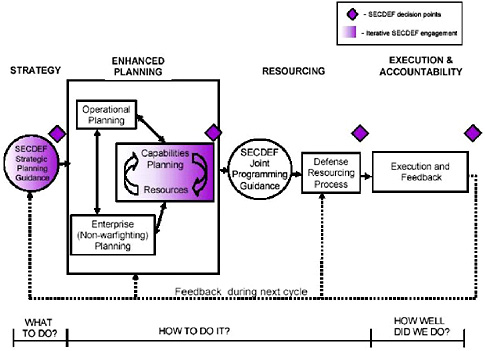
FIGURE 4.1 The new process for the Department of Defense’s future force/program planning. NOTE: SecDef, Secretary of Defense. SOURCE: Joint Defense Capabilities Study Team. 2004. Joint Defense Capabilities Study: Improving DoD Strategic Planning, Resourcing, and Execution to Satisfy Joint Requirements, Final Report, Department of Defense, Washington, D.C., January, p. v.
Of particular note is the intent that the likely limits on available funding will inform the program planning process starting with the initial Strategic Planning Guidance, rather than being disruptively imposed at the end of the process as the next budget request is being finalized. In principle, each Service will no longer be able to argue that it needs more money if it is to follow the Secretary’s guidance. The analytic heart of this process is the Enhanced Planning Process and its associated Analytic Agenda, which is designed to identify and assess specific elements of DOD’s future capabilities for early decision by the Secretary and promulgation in the Joint Programming Guidance, before the Services build their POMs. An additional aspect of the new process worth highlighting is the increased role of the combatant commanders, who are now participating much earlier in the planning cycle than was previously the case. In this regard, they are encouraged to express their needs in terms of “capabilities,” not specific budgetary items.
Weapons Systems Requirements and Acquisition Management
In addition to the primary planning, programming, budgeting, and execution (PPBE) process, the DOD has also historically employed two other management systems that impinge on the capabilities-based planning process—the weapons systems requirements process and the acquisition management system.
Weapons Systems Requirements
The weapons systems requirements process has traditionally been the province of the military Services. The respective Services are the experts in their forms of warfare and have routinely been the initiators of formal “requirements” for new weapons systems (including command, control, communications, computers, intelligence, surveillance, and reconnaissance (C4ISR) systems). These formal requirements in turn are refined as performance capabilities requirements suitable for inclusion in requests for proposals and subsequent contracts.
The growing emphasis on the need for more “jointness” in military operations has also led to efforts to increase jointness among the Services in their acquisition of weapons systems—particularly those important to battlefield interoperability among Service elements. The resulting Joint Requirements Oversight Council (JROC) review of major new, Service-proposed weapons systems was intended to support this goal. However, the JROC has usually been viewed as only a minor bureaucratic speed bump that might slow but not alter Service programs. It has been viewed this way in part because most programs are well advanced by the time they are reviewed by the JROC, in part because there has been little truly joint warfighting doctrine or planning that could inform critical review, and in part because there is little incentive for military officers on the Joint Staff to reach conclusions at odds with those of their parent Service. Fur-
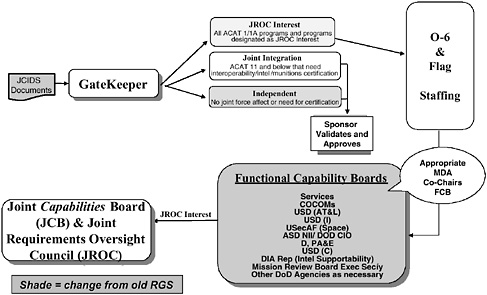
FIGURE 4.2 The Joint Capabilities Integration and Development System (JCIDS) process. SOURCE: LTC Robert Larsen, USA, Chief, Plans Branch, Joint Capabilities Development, and J8, Director for Force Structure, Resources, and Assessment, “As Warfighting Capability Based Analysis and Assessment Evolves: Are We Solving the Right Problem?,” presentation to the committee, July 27, 2004, Woods Hole, Mass., slide 42.
thermore, the fact that the JROC only reviews major weapons systems ensures that most of the command, control, and communications and the intelligence, surveillance, and reconnaissance programs that are important to mechanizing true jointness are not being formally considered in the joint arena.
One of the transformational initiatives of Secretary Rumsfeld was to increase emphasis on the joint nature of military operational and future planning, which includes emphasis on ensuring that new weapons systems are “born joint.”1 This latter emphasis results from repeated military interoperability problems in the field over the past several decades, despite repeated policy directives intended to preclude such problems. In 2003 this initiative resulted in the Chairman of the Joint Chiefs of Staff’s (CJCS’s) formally changing the Joint Staff requirements process by establishing the Joint Capabilities Integration and Development System (JCIDS). This process is illustrated in Figure 4.2.
|
1 |
DOD 2003. Transformation Planning Guidance. Available at <http://64.233.161.104/search?q=cache:tFLupyoy9wkJ:www.oft.osd.mil/library/library_files/document_129_Transformation_Planning_Guidance_April_2003_1.pdf+DoD+transformation+&hl=en>. Last accessed on December 3, 2004. |
The responsibilities of the the new JCIDS are to provide an enhanced methodology utilizing joint concepts that will (1) identify and describe existing or future shortcomings, as identified against current or future capabilities or as measured against current or projected threat capabilities; (2) identify and describe redundancies in warfighting capabilities; (3) describe the attributes of effective solutions; and (4) identify the most effective approach or combination of approaches to resolve those shortcomings.
The JCIDS process could be interpreted in some ways as intending to deal with elements of the DOD force structure and posture beyond just weapons systems. As a practical matter, however, JCIDS and its several functional components are focused almost exclusively on the acquisition of new equipment and not on force levels or postures.
Acquisition Management
Once a formal requirement for a new weapon system has been established (and approved by the JROC for major new systems) and a Service has included funds in its future-years program proposal, subsequent development and acquisition are governed by the formal DOD acquisition process. This process is substantively separated from the PPBES but is ultimately subordinate to it in the sense that decisions in the PPBES (in the DOD and in Congress) determine the flow of funds to each individual weapons system program.
Each of the past two administrations repeatedly attempted to revise the formal weapons systems acquisition process to remove perceived barriers to the acquisition of cutting-edge commercial technology and also to speed up the fielding of new systems. Despite extensive rewriting of procedural documents and some improvement in the department’s ability to acquire commercial products, the sound systems-engineering practices recommended by the Packard Commission almost two decades ago remain in place: Fly-before-Buy, do milestone reviews, and do careful cost-performance tracking of progress.2 Furthermore, many of the perceived impediments to the use of speedier procurement practices more like those in the commerical world are rooted in congressional requirements for full and open competition, detailed reporting of costs, frequent outside audits, and other steps designed to protect the integrity of the use of taxpayer funds. These considerations, which are firmly embedded in the culture of the DOD acquisition community, have tended to stymie many aspects of proposed acquisition reforms.
|
2 |
Report of the President’s Blue Ribbon Commission on Defense (also known as the Packard Commission). 1986. Available at <http://www.ndu.edu/library/pbrc/pbrc.html>. Last accessed on December 3, 2004. |
Although DOD acquisition management has, at least in recent years, focused on overseeing programs individually, there has been a recent recurrence of interest in broader, “capabilities area” analysis within the acquisition community. This approach is depicted in the Figure 4.3.
The roadmaps depicted at the intersection of the requirements phase and the acquisition phase in this figure are intended to result from “capabilities area” studies to be led by the acquisition community. To the committee’s knowledge, this aspect of the DOD capabilities-based planning process has yet to be reconciled with the JCIDS and PPBE efforts.
Recent Activity
The Joint Defense Capabilities Study (also known as the Aldridge Study) is a major independent study chartered by the Secretary of Defense “to examine how the Department of Defense (DoD) develops, resources, and provides for joint capabilities.”3 The study group recommended “a capabilities-based process for identifying needs, creating choices, and providing capabilities,” and it attempted to address capabilities-based planning across all elements of the future defense program.4 One member of the present committee was assigned to that study throughout its term. The OSD’s Program Analysis and Evaluation official who briefed the committee was also a member of the Aldridge Study team.
The Aldridge Study was favorably received by the Secretary, who directed that its major recommendations be implemented, except for organizational changes. At the time of this committee’s workshop, it was clear that the implementation of the study’s capabilities-based planning recommendations was at an early stage, with many conceptual and procedural details remaining to be worked out. It is this ongoing implementation process that provides the Navy with an opportunity to contribute to and influence the resulting new resource management process.
An overview of the capabilities-based planning process recommended by the Aldridge Study is presented in Figure 4.4.
As may be seen, it is the Secretary’s intent that the department’s program planning process become more output- and capabilities-focused, and that major options be developed, analyzed, and brought forward to him for decision. Unfor-
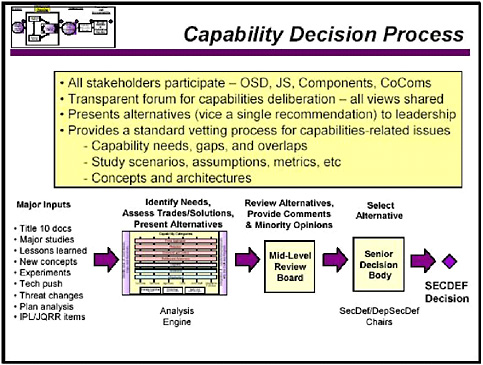
FIGURE 4.4 Capability decision process as recommended by the Aldridge Study. NOTE: OSD, Office of the Secretary of Defense; JS, Joint Staff; CoComs, combatant commanders; IPL/JQRR, Integrated Priority List/Joint Quarterly Readiness Review; SECDEF, Secretary of Defense. SOURCE: Joint Defense Capabilities Study Team. 2004. Joint Defense Capabilities Study: Improving DoD Strategic Planning, Resourcing, and Execution to Satisfy Joint Requirements, Final Report, Department of Defense, Washington, D.C., January, p. B-17.
tunately, the Aldridge Study was not able to describe in useful detail the process intended for mapping the broad capabilities categories defined in the study5 into the programmatic and budgetary detail necessary for constructing and assessing clear budgetary alternatives for the Secretary’s decisions. As a result, there continues to be an extensive follow-on staff effort involving OSD, the Joint Staff, and all Services and agencies led by J8/USD (P)/PA&E (Director for Force Structure, Resources, and Assessment/Under Secretary of Defense for Policy/
Program Analysis and Evaluation). The committee understood from both Navy and non-Navy briefers that the Navy’s involvement in these ongoing efforts is marginal, which in turn sharply limits the Navy’s ability to influence the emerging process.
The goal of the ongoing joint effort is to refine the capabilities-based planning process to allow the Secretary’s intent to be more fully realized. This staff effort involves a multiplicity of Joint Staff/OSD/Service activities that are intended to bring more substance and coherence to the new JCIDS, acquisition, and PPBES processes that are to be integrated into a cohesive whole. These staff activities include the drafting and coordination of documents such as formal Joint Operational Concepts, Joint Integrating Concepts, and Joint Operating Concepts. In addition, the capabilities categories initially nominated by the Aldridge Study have had to be partitioned into more manageable aggregations of capabilities suitable for analysis and programmatic decisions. This process involves new Functional Area Analyses, Functional Needs Analyses, and Functional Solutions Analyses that have the potential, at least in theory, of developing real alternatives to programs preferred by the Services.
NAVY PROGRAM PLANNING
It is the Navy’s approach to the capabilities-based aspects of the DOD program planning process described above that has been a major focus of this committee’s deliberations. The CNO’s guidance to the Navy for 2004 emphasized joint capabilities. However, the committee saw very little evidence of jointness in the process that the Navy uses to develop its multiyear program plan, as that process was explained to the committee. Furthermore, the committee saw no evidence that the CNO’s guidance was updated in response to the Secretary of Defense’s Strategic Planning Guidance, which was issued late in the cycle.
The Navy’s choice of its Sea Power 21 construct as the primary basis for planning its forces is a potential source of a significant problem. There is not yet adequate linkage between the Sea Power 21 framework and the DOD capabilities-based planning framework. This dichotomy is recognized by the Navy, as illustrated in Figure 4.5.
Supporting Analysis
The Navy has a long history of conducting detailed quantitative analysis at several levels of aggregation, in support of both Navy program planning and the operational planning of naval component commanders. The committee was briefed in general on several of the Navy’s ongoing analytic efforts, including major campaign analyses of potential future conflicts. Such studies were conducted at several locations within the Navy staff, its field activities, and system commands. Principal offices include the Deputy Chief of Naval Operations
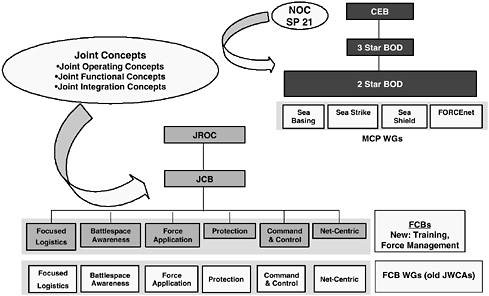
FIGURE 4.5 Navy and Joint Capabilities Integration and Development System (JCIDS) executive and decision-making process. NOTES: NOC, Naval Operating Concept; SP 21, Sea Power 21; CEB, CNO Executive Board; BOD, Board of Directors; MCP WG, Mission Capability Planning Work Group; JROC, Joint Requirements Oversight Council; JCB, Joint Capabilities Board; FCB, Force Capabilities Board; JWCA, Joint Warfighting Capabilities Assessment. SOURCE: LCDR Kenneth M. Masson, USN, Office of the Deputy Chief of Naval Operations for Resources, Requirements, and Assessments, N815F/ N00X, “Capabilities Based Planning—Integrating into the Joint Process,” presentation to the committee, July 27, 2004, Woods Hole, Mass., slide 10.
(DCNO) for Warfare Requirements and Programs (N7), which is responsible for the end-to-end building and integration of the Navy Future Force Plan/Program Objective Memorandum (POM); the Assessments Division of the Office of the DCNO for Resources, Requirements, and Assessments (N81), which is responsible for assessing the POM on behalf of the CNO and interfacing with the joint/ OSD future force planning process; and the systems commands that are responsible for the architectures and interoperability assessments of each of the pillars, or major naval concepts, of Sea Power 21. Additional campaign-type analyses are conducted by the Navy Warfare Development Command (NWDC), but these are primarily in support of near-term operational planning needs, not longer-term force planning.
The material presented to the committee indicated that many of these Navy campaign analyses are structured around scenarios that the Navy believes are appropriate for its purposes. These scenarios do not, however, comport in signifi-
cant details with the Defense Planning Scenarios that the Secretary’s office has promulgated for use department-wide in all future force planning. It is understandable that the Navy would want to conduct excursions from the basic analytic framework used elsewhere in the department. Nonetheless, the committee believes that the Navy’s credibility with OSD is jeopardized by its not clearly employing these DOD scenarios as basic building blocks in its force planning process. The fact that N81 may come close to employing these scenarios in its assessment process at the end of the POM development cycle does not compensate adequately for their lower priority during the formative stages of the POMs. Indeed, the committee observes that the analytic capabilities of N81 appear insufficiently robust to compensate effectively for their basic shortcoming. In particular, the N81 analyses briefed to the committee were narrowly focused on specific issues and did not purport to critically review or replicate the overall POM development process as conducted within the N7 organization. Indeed, much of the analytic capability within the Navy staff appears to be excessively stovepiped and unresponsive to the higher needs of capabilities-based future force planning. Only in the case of the Office of the DCNO for Fleet Readiness and Logistics (N4) and, to a lesser extent, the Office of the DCNO for Manpower and Personnel (N1) did it appear to the committee that analytic efforts were directly responsive to top-level guidance.
More generally, the Navy’s force planning analytic activities were not shown to the committee to be linked in any meaningful way with the Aldridge Study’s Enhanced Planning Process and its associated Analytic Agenda, endorsed by the Secretary of Defense in October 2003.
An Example: Homeland Defense
Homeland defense—that is, the direct defense of the United States against external attack—is described as the DOD’s highest priority. Yet, with the exception of the Navy’s program to grow the capability of its Aegis ships to detect, track, and eventually engage a larger spectrum of cruise and ballistic missiles, there was no evidence presented to the committee of Navy programs that are intended, for example, to provide broad, active surveillance of the approaches to the United States from which terrorist or hostile state attacks could be launched in the future. While the committee understands that the capabilities needed to accomplish this mission have not been fully defined, the fact that the mission was nowhere visible in the material presented to the committee was troubling.
Navy/Marine Corps “Jointness”
A significant portion of the U.S. Navy is directly committed to providing effective joint capabilities with the U.S. Marine Corps. This is increasingly true as the Navy has shifted its emphasis to operations in the littorals, including
greater emphasis on sea basing. However, in its workshop, the committee was shown no evidence of the type of integrated Navy/Marine Corps program planning and analyses that one would expect if the Department of the Navy was attempting to optimize its investment in such combined forces. This suggests that the Navy and Marine Corps are continuing to develop their individual programs in excessive isolation. The Navy’s ability to interact productively in the larger program planning process involving joint forces capabilities could well be enhanced by being able to present a program well-integrated with that of the Marine Corps. This program could be a model for future use as the need to jointly plan future sea basing with the Army and Air Force evolves.
RECOMMENDATIONS
Recommendation 5: The Chief of Naval Operations should direct that Navy force planning consistently include use of the baseline scenarios (including concepts of operations, threat assessments, and so on) specified by the Office of the Secretary of Defense. The Chief of Naval Operations should also work with the Secretary of the Navy and the Commandant of the Marine Corps to establish a more integrated, joint Navy/Marine Corps Program Objective Memorandum development process that could serve as a model for the Department of Defense more broadly. Navy force planning should also include extensive exploration to lead to better understanding of the consequences of scenario details and other assumptions of analysis.
Of course, within the extensive exploration recommended above, Navy planning should address in particular depth those scenarios and the cases within them that affect Navy missions, capabilities, and needs. The point here, however, is that the Navy should address the DOD’s standard baseline cases to be a creditable joint participant.
During the workshop, Navy briefers described their organizations’ attempts to cover all the bases in CBP meetings called by OSD and OJCS personnel, but indicated that the organizations had insufficient resources to participate fully and effectively. Some lack of coordination and of internal Navy scheduling control was also evident. This may be due in part to the lack of clarity in OPNAV lines of responsibility for CBP activities; that lack sometimes results in a duplication of effort. In addition, other information provided to the committee indicates that the Navy is not always well represented in the DOD joint CBP processes. Several non-Navy briefers noted that Navy representatives on the various boards and committees are often unfamiliar with the issues, not empowered to speak on behalf of the Navy, or absent. Regardless of whether these difficulties result from insufficient staff resources or other problems, they preclude justice being done to naval issues in the larger DOD environment and undercut Navy interests in competition for both influence and funding.
Recommendation 6: Over the longer term, the Chief of Naval Operations should identify and staff a central activity that is charged with the responsibility for harmonizing the Navy’s capabilities-based planning processes with those of the larger Department of Defense (DOD) force planning community, and should staff that activity to represent Navy interests effectively in the DOD joint planning activities.
Currently, the most logical place for this assignment would be in the Office of the DCNO for Resources, Requirements, and Assessments, because the processes involved in capabilities-based planning include resource-allocation issues across all force and support areas. However, the decision on how best to accomplish the tasking for such a central activity should logically follow from or be consistent with the model chosen by the CNO to assure having a highly competent analytical group to support him on all aspects of capabilities-based planning. In the short term, to make the best possible utilization of resources, a possible solution would be to designate one individual (e.g., the director of the Navy staff) to be responsible for resolving any capabilities-based planning coordination problems within the OPNAV staff.

